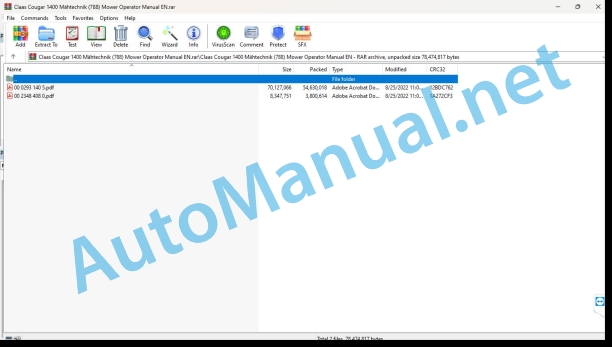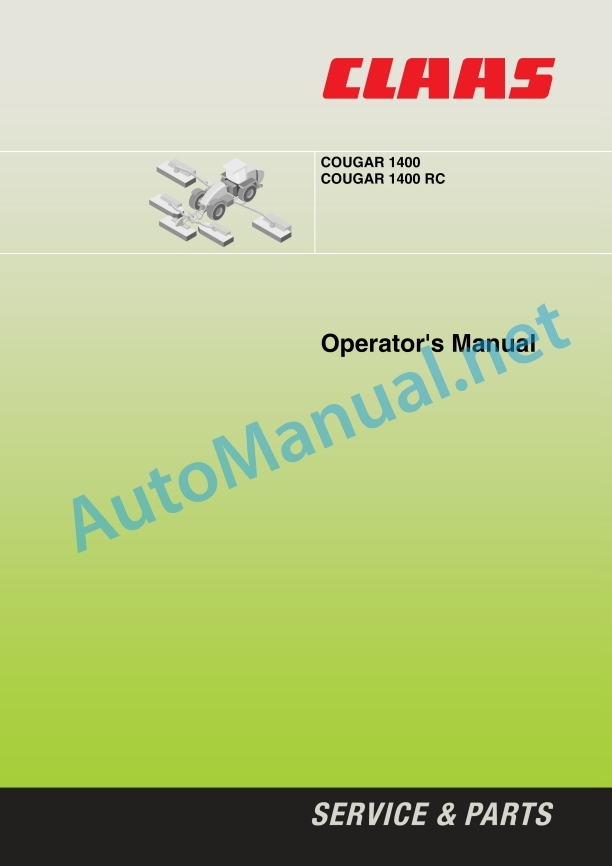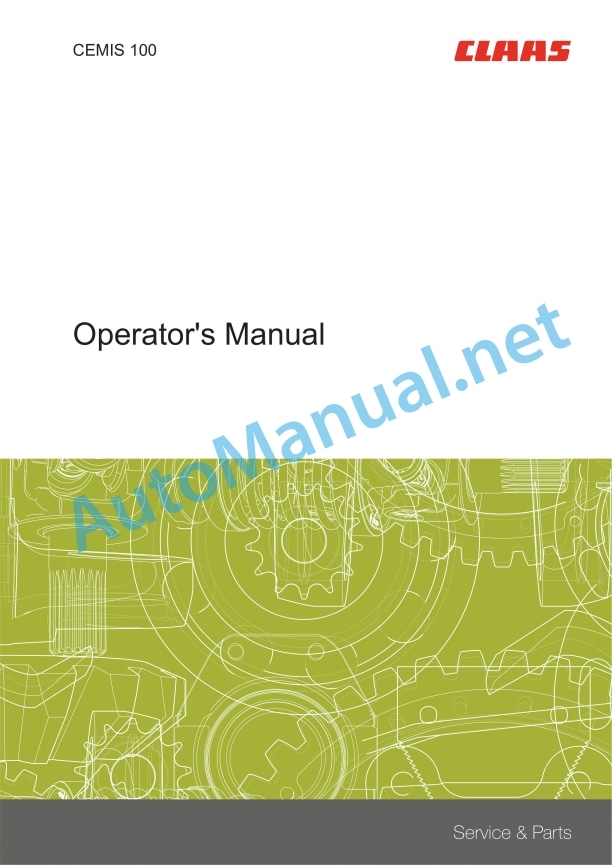Claas Cougar 1400 Mahtechnik (788) Mower Operator Manual EN
$50.00
- Model: Cougar 1400 Mahtechnik (788) Mower
- Type Of Manual: Operator Manual
- Language: EN
- Format: PDF(s)
- Size: 55.7 MB
File List:
00 0293 140 5.pdf
00 2348 408 0.pdf
00 0293 140 5.pdf:
1 Contents
2 Machine description
3 Introduction
3.1 Introduction
3.2 Validity
4 General instructions
4.1 Road travel
4.2 Of special importance
4.3 Identification plate / serial number
4.3.1 Identification plate / machine number
4.3.2 Engine serial number
4.3.3 Identification plate, auxiliary gearbox
4.3.4 Transmission identification plate
4.3.5 Axle identification plate
4.3.6 Identification plate of telescopic outrigger on mower unit, centre left
4.3.7 Identification plate of telescopic outrigger on mower unit, centre right
4.3.8 Identification plate of mower units, centre left / right and front centre
4.3.9 Identification plate of mower unit, front left
4.3.10 Identification plate of mower unit, front right
4.3.11 Identification plate of hitch frame, mower unit front
5 Safety Rules
5.1 Safety Rules
5.2 Wheel chocks
5.2.1 Applying the wheel chocks
5.3 Battery isolator switch
5.4 Safety decals with pictorials
6 Specifications
6.1 CLAAS Cougar 1400 / 1400 RC
6.1.1 Engine
6.1.2 Ground drive
6.1.3 Steering
6.1.4 Brakes
6.1.5 Hydraulic system
6.1.6 PTO drives
6.1.7 Tyres and air pressures
6.1.8 Tightening torques
6.1.9 Mower units
6.1.10 Dimensions
7 Prior to operation – basic machine
7.1 Cabin
7.1.1 Roof console – overview
7.2 Air conditioner
7.2.1 Operating and display elements
7.2.2 Putting the air conditioner into operation
7.2.3 Adjusting the cabin temperature
7.2.4 Manually setting the evaporator fan speed
7.2.5 Activating ECON mode
7.2.6 Deactivating ECON mode
7.2.7 REHEAT operation (demisting cabin windows)
7.2.8 Displaying the outside temperature
7.2.9 Changing the temperature display to _x001E_ Fahrenheit
7.2.10 Heating the leg area
7.2.11 Fault indicator
Temperature sensor F0 fault indicator (cabin, blue)
Temperature sensor F1 fault indicator (outlet, yellow)
Temperature sensor F2 fault indicator (outside, red)
7.3 Mirror
7.3.1 External mirror (A) “Road Travel”
7.3.2 Switching on the mirror heating
7.3.3 Adjusting “Working” mirrors
7.3.4 Starting mirror (optional equipment)
7.4 Adjusting the lighting
7.4.1 Driving lights
7.4.2 Working lights
7.4.3 Sidefinder (optional equipment)
7.4.4 Pathfinder lighting
7.5 Roll-up sun blinds
7.5.1 Sun blinds front / back
7.5.2 Side sun blinds
7.6 Cabin roof
7.6.1 Opening the cabin roof
7.6.2 Closing the cabin roof
7.7 Control panel
7.8 Central electrical system
Electronic components (D)
Modules (A)
Fuses (F)
Relays (K)
Main fuse
7.9 Adjusting the operator’s seat
7.10 Adjusting the steering column
Swing the steering column downwards
Swinging the steering column upwards
Adjusting the steering wheel height
Vehicle information unit
Multifunction switch
7.11 Multifunction han Groundtrol lever
7.13 Windscreen washer
7.13.1 Windscreen washer – front screen
7.13.2 Windscreen washer – side windows (additional equipment)
7.14 Tyres
7.14.1 Mudguards on the mower unit axle
8 Prior to operation – mower units
8.1 Check and observe the following prior to operation!
8.2 Hitching up front mower units
8.3 Prop stands
8.3.1 Raising prop stands
8.3.2 Lowering prop stands
8.4 Hitching up / parking the front mower units
8.5 Fitting the mower blades
8.6 Swath plates
8.7 Accessory equipment for mower unit
8.7.1 Warning beacon
8.7.2 Additional clearance lights (optional equipment)
8.7.3 High cutting skids (B03 0020)
9 Operation – basic machine
9.1 Driving the Cougar
9.1.1 Starting the engine
9.1.2 Ignition lock
9.1.3 Starting the engine
9.1.4 Select steering programme
9.1.5 Foot switch “Crab steer mode”
9.1.6 Starting to drive
9.1.7 Select the gear
9.1.8 Adjusting the engine speed
9.1.9 Using the drg control lever
.1.10 Engaging / disengaging the differential locks
Engaging the automatic differential lock
Manual engagement of the differential lock
9.1.11 Stopping
Stopping with the driving control lever
Stopping with the foot brake
9.1.12 Brakes
Foot brake
Parking brake
9.1.13 Parking the vehicle
9.1.14 Towing the vehicle
9.1.15 Emergency operation – basic machine (Limp-Home)
9.1.16 Rotating the driver’s cabin
9.1.17 Reversing fan
Manual activation of recirculation fan
10 Operation – mower units
10.1 Overview of controls
10.1.1 Control panel
10.1.2 Multifunction handle
Reversal switch M16
10.1.3 Master switch (S4) “Mower unit drive”
10.1.4 Automatic function
10.1.5 Semi-automatic function
10.1.6 Sequence control
10.1.7 Manual operation
10.1.8 Example “Semi-automatic function”
10.1.9 Example “Manual operation”
10.2 Functions
10.2.1 Working position
10.2.2 Hydraulic sSetting the lower / u Adjusting the lower link
Adjusting the upper link
10.2.3 Mower unit drive
10.2.4 Collision protection
10.2.5 Headland position
10.2.6 Folded position
10.2.7 Mower unit floating
Enabling mower unit floating
10.2.8 Working width of mower unit
10.3 Mowing
10.3.1 Instructions for mowing
10.3.2 Working with single mower units
10.3.3 Recommendation for environmental protection
10.3.4 Cutting height
10.3.5 Swath width COUGAR 1400
10.3.6 Swath width COUGAR 1400 RC
10.3.7 Conditioner COUGAR 1400
10.3.8 Mowing without conditioning effect (COUGAR 1400 RC only)
10.4 Transport position
10.5 Emergency operation – mower units
11 Operation – CEBIS
11.1 CLAAS CEBIS on-board information system
11.2 CEBIS monitor and rotary switch
11.2.1 Keypad C
11.2.2 Rotary switch D
11.2.3 Multi-function controller M
11.2.4 Screen areas E (Road view)
11.2.5 Screen areas E (Work view)
11.3 Navigation
11.4 Status display of mower units
11.5 “Settings” Menu
11.5.1 CLAAS data set
11.5.2 Custom settings
11.5.3 Current data set
11.5.4 Calling the “Settings” menu
11.5.5 Display settings
11.5.6 Loading settings
11.5.7 Changing the settings
11.5.8 Storing the current settings
11.6 “Vehicle” menu
11.6.1 Calling the “Vehicle” menu
11.6.2 Adjusting the working speed
11.6.3 Adjusting the working speed directly
11.6.4 Programming the reversing fan
Adjusting the type of actuation for the reversing fan
11.6.5 Adjusting the reversing interval
11.6.6 Adjusting the duration of fan reversal
11.6.7 Setting the field travel mode
11.6.8 Adjusting the steering
11.6.9 Steering programs
4-wheel steering with regaining – standard steering
4-wheel steering without regaining
Crab steer mode
11.6.10 Changing the steering program
11.6.11 Monitor display – steering programs
11.6.12 Calling up the “Steering” menu
-wheel steering
11.6.14 Setti 11.6.15 Setting maximum crab steering angle
11.6.16 Setting the crab steer mode directly
11.6.17 Setting up the crab steering angle
11.6.18 Changing the crab steering angle
11.6.19 Displaying the driving information
11.7 “Driving information” menu
11.7.1 Displaying the driving information
11.7.2 Resetting the service counter
11.8 “Ground pressure” menu
11.8.1 Calling the “Ground pressure” menu
11.8.2 Setting the float set value
11.8.3 Setting the float directly
11.8.4 Display of float in the working view
11.9 “Overlap menu”
11.9.1 Calling the “Overlap” menu
11.9.2 Adjusting the overlap set value
11.9.3 Adjusting the overlap for straight line travel / curve travel
11.9.4 Adjusting the connection overlap
11.9.5 Direct adjustment of the overlap for straight ahead travel
11.9.6 Overlap display in the working view
11.10 “Headland” menu
11.10.1 Calling the “Hedjusting the headland heights
11.10.3 Time-dependd-dependent delay
11.10.5 Changing over the headland mode
11.10.6 Changing the headland settings
11.11 “Lifting unit” menu
11.11.1 Call the “Lifting unit” menu
11.11.2 Adjusting the lifting unit
Adjusting the lower link
Adjusting the upper link
11.12 “Maintenance menu”
11.12.1 Call the “Maintenance” menu
11.12.2 “CEBIS” menu
11.12.3 Call the “CEBIS” menu
11.12.4 “Monitor contrast” menu
11.12.5 Direct adjustment of monitor contrast
11.12.6 “On-board Diagnostics” menu
11.12.7 “Emergency adjustment” – of mower units
Calling the “Emergency adjustment” menu
11.12.8 “Limit stops” menu
11.12.9 Calling the “Limit stops learning” menu
11.12.10 “End stops” menu – Mower unit
11.12.11 “Pulses per 100 m” learning menu
11.12.12 Menu “Limit stops” – ground speed control lever / hydrostat
11.12.13 He
11.12.15 “Units” menu
11.12.16 “Language” menu
11.12.17 Se.19 “Counter” menu
11.12.20 Calling the “Counter” menu
11.12.21 Resetting the “Day” counter menu
11.13 Faults and remedies
11.13.1 Fault signal / long alarm signal
11.13.2 Warning signal / three alarm signals
11.13.3 Information signal / one alarm signal
11.13.4 Emergency mode
11.14 Fault code table
12 Maintenance – basic machine
12.1 Important maintenance instructions
12.1.1 Important maintenance instructions and safety rules
12.2 Maintenance schedules and lubricants charts
12.2.1 Maintenance schedule – basic machine
12.2.2 Lubricants chart – basic machine
12.3 Protective enclosures
Opening the lower engine hood
Opening the upper engine hood
Opening the vehicle hood
Closing the vehicle hood
12.4 Hydraulic system
12.4.1 Pressure accumulator
12.4.2 Checking the hydraulic oil e hydraulic oil
12.4.4 Replacing the hydraulic oil filter in the working hydraulics
12.4.5 Replacing the hydraulic oil filter in the drive transmis4.6 Replacing the suction filter
12.4.7 Replacing the venting filter
12.4.8 Topping up hydraulic oil
12.5 Gearbox
12.5.1 Drive gearbox
Checking transmission oil level
Changing the transmission oil
Topping up transmission oil
12.5.2 Transfer gearbox engine take-off
Check oil level in transfer gearbox
Changing the oil in transfer gearbox
Topping up the oil in transfer gearbox
12.5.3 Transfer gearbox of mower units
Check oil level in transfer gearbox
Changing the oil in mower unit transfer gearbox
Topping up the oil in mower unit transfer gearbox
12.6 Axles
12.6.1 Check planetary gear oil level
12.6.2 Changing the planetary gear oil
12.6.3 Check differential oil level
12.6.4 Changing the differential oil
12.7 Chassis
12.7.1 Wheels / tyres
12.7.2 Check tightening torques of wheel nuts / wheel bolts
12.8 Air conditioner
12.8.1 Checking / cleaning the condenser
12.8.2 Checking the refrigerant level
12.8.3 Checking the moisture saturation of the filter drier
12.9 Cabin
12.9.1 Cleaning / replacing the cabin filters
12.9.2 Cleaning the units located in the cabin roof
12.9.3 Checking the windscreen washer
12.10 Compressed air system / brakes
12.10.1 Compressed air connection point
Take care when removing air
12.10.2 Checking / tightening the retaining straps
12.10.3 Checking / cleaning the drain valve
12.10.4 Checking the pressure regulator
12.10.5 Checking the safety valve
12.10.6 Releasing the parking brake
12.11 Drive belts centre mower unit left / right
12.11.1 Removing the drive belts
12.11.2 Fitting and tensioning the drive belts
12.12 Drive belts, front PTO shaft
12.12.1 Removing drive belts, front PTO shaft
12.12.2 Fitting and tensioning the drive belts
12.13 Cleaning and care
12.14 Recommendations for winter storage
13 Maintenance – mower units
13.1 Important maintenance instructions
13.1.1 Hydraulic system
13.1.2 Energy-storage devices / springs
13.1.3 Bolts
13.1.4 Lubrication
13.1.5 Protective devices (guard frames)
13.2 Maintenance and lubrication charts
13.2.1 Maintenance schedule – mower units
13.2.2 Lubricant chart – mower units
13.3 Drive diagram COUGAR 1400
13.4 Drive diagram COUGAR 1400 RC
13.5 Drive Systems
13.5.1 Gearboxes
Main gearbox in hitch frame
Main gearbox of front centre mower unit
Gearbox of front left and right mower unit
Side gearbox of front centre mower unit, centre left and right
Main gearbox of centre left and right mower unit
13.5.2 Drive train of mower unit left / right
13.6 V-belts
13.6.1 Checking V-belts
13.6.2 Tensioning the conditioner drive belts, COUGAR 1400
13.6.3 Conditioner, COUGAR 1400 RC
Tensioning drive belts
Replacing drive belts
13.7 Mower head
13.8 Wrapping guard
13.9 Mower blades
13.9.1 Mower blade box
13.9.2 Replacing the mower blades
13.9.3 Quick-change system for mower blades
13.9.4 Mower blade mounting studs (mower blade quick change system)
13.9.5 Bolted mower blades
13.9.6 Mower blade fixing (bolted version)
13.10 Cutting discs
13.10.1 Replacing cutting discs
13.11 Conditioning tines
13.11.1 Installing and removing the tines
13.12 Conditioner rollers
13.12.1 Adjusting synchronous running
13.12.2 Adjusting the roller spacing
13.13 Spring adjustment
13.13.1 Adapting front centre mower unit to ground contour
13.13.2 Adapting centre left and right mower unit to ground contour
13.13.3 Restricting adaptation of centre left and right mower unit to ground contour
13.13.4 Tension springs – conditioner rollers
13.14 Telescopic outrigger
13.14.1 Adjusting the play
13.14.2 Lubricating the telescopic outriggers
13.15 Electrical
13.15.1 Speed sensor up to serial no. 788 0 1051
13.15.2 Speed sensor from serial no. 788 0 1052
13.15.3 Angle sensor on centre left and right mower unit swing arm
13.15.4 Angle sensor of hydraulic system
13.15.5 Measuring cable
13.16 Clutches
13.17 Drive shaft
13.17.1 General information on universal drive shafts
Fitting note
13.17.2 Removing and mounting guard cones
13.18 Hydraulic system
13.18.1 Hydraulic hoses
13.18.2 Pressure accumulator
13.18.3 Hydraulic cylinder with vacuum valve
13.19 Lubrication holes
13.20 Screw connections
13.21 Connecting elements
13.22 Cleaning and care
13.23 End of season storage
14 Maintenance – engine
14.1 Important maintenance instructions
14.1.1 Important maintenance instructions and safety rules
14.2 Maintenance and lubricants chart
14.2.1 Maintenance schedule – engine
14.2.2 Lubricant charts – engine
14.3 Engine Overview
14.4 Fuel system – engine oil – V- belts
14.4.1 Fuel System
Fuel tank
Manual fuel pump with fuel pre-cleaner
Fuel filter
Checking the water separator / draining water
Replacing the fuel pre-filter cartridge
Replacing the fuel pre-filter cartridge (optional equipment)
Venting the fuel system
14.4.2 Engine oil level check
14.4.3 Changing the engine oil
14.4.4 Changing the oil filter
14.4.5 Changing breather filter
14.4.6 Top up engine oil
14.4.7 Ventilator and three-phase alternator drive belts
Checking the drive belt condition
Checking the screwed connections
14.5 Cooling system
14.5.1 Coolant
14.5.2 Observe coolant type
14.5.3 Identifying the coolant type
14.5.4 Topping up the coolant
14.5.5 Change the coolant
14.5.6 Coolant dilution relationship
14.5.7 Draining the coolant
14.5.8 Topping up coolant
14.5.9 Over-pressure
14.5.10 Coolant temperature
14.5.11 Clean the water cooler, oil cooler and intercooler
14.5.12 Cleaning rotor
14.6 Air filter – battery – engine faults
14.6.1 Dry-type air filter
14.6.2 Warning device
14.6.3 Cleaning the air filter suction sieve
14.6.4 Cleaning dry-type air filter
14.6.5 Replacing the safety cartridge
14.6.6 Battery
14.6.7 Checking the acid level and acid strength
14.6.8 Threephase alternator
14.6.9 Engine faults, causes and remedies
14.7 Cleaning and care
14.8 Over-wintering suggestions for the engine
14.8.1 Engine preservation
15 Lubrication chart – basic machine
15.1 Lubricants and notes
16 Lubrication chart – mower units
16.1 Lubricants and notes
17 Index
00 2348 408 0.pdf:
CEMIS 100
Table of contents
1 Introduction
1.1 General information
1.1.1 Validity of the manual
1.1.2 Information about this Operator’s Manual
1.1.3 Symbols and notes
1.2 Intended use
1.2.1 Intended use
1.2.2 Reasonably foreseeable misuse
2 Safety
2.1 Safety rules
2.1.1 General safety and accident prevention regulations
2.1.2 Interaction between terminal and machine or tractor
2.1.3 Electrocution by electrical system
3 Product description
3.1 Overview and method of operation
3.1.1 Overview of CEMIS 100
3.1.2 Function principle of CEMIS 100
3.2 Identification plates and identification numbers
3.2.1 Spare parts and technical questions
3.2.2 Identification plate of CEMIS 100
4 Operating and display elements
4.1 CEMIS 100
4.1.1 User interface for LINER
4.1.2 User interface for ROLLANT
4.1.3 User interface for UNIWRAP
5 Technical specifications
5.1 CEMIS 100
5.1.1 Specification
6 Operation
6.1 CEMIS 100
6.1.1 Operating the CEMIS 100
6.1.2 Switching CEMIS 100 on
6.1.3 Switching CEMIS 100 off
7 Maintenance
7.1 CEMIS 100
7.1.1 Daily
8 Putting out of operation and disposal
8.1 General information
8.1.1 Removal from service and disposal
9 Technical terms and abbreviations
9.1 Terms and explanations
9.1.1 Technical words
9.1.2 Abbreviations
John Deere Repair Technical Manual PDF
John Deere Application List Component Technical Manual CTM106819 24AUG20
John Deere Parts Catalog PDF
John Deere Harvesters 8500 and 8700 Parts Catalog CPCQ24910 Spanish
John Deere Repair Technical Manual PDF
John Deere Repair Technical Manual PDF
John Deere Diesel Engines POWERTECH 2.9 L Component Technical Manual CTM126 Spanish
John Deere Repair Technical Manual PDF
John Deere Repair Technical Manual PDF
John Deere Repair Technical Manual PDF
John Deere Repair Technical Manual PDF
John Deere Repair Technical Manual PDF























